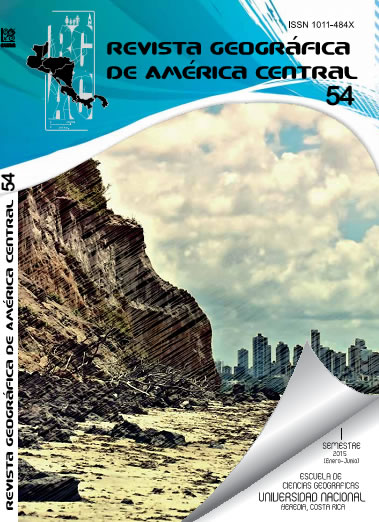ECOLOGICAL CONDITIONS OF THE SAN BERNARDO STREAM’S LOW BASIN, SIERRA DE LA VENTANA, ARGENTINA
DOI:
https://doi.org/10.15359/rgac.1-54.6Keywords:
Ecological status, San Bernardo stream, Hydrogeomorphological Index, fluvial geomorphologyAbstract
The ecological status of a river is the measure of quality in the structure and functioning of the aquatic ecosystem. Geomorphological processes determine a variety of habitats, thus promoting biodiversity and productivity of aquatic and coastal ecosystems. The hydrogeomorphological indicators are key to determining the ecological status of rivers. The hydrological dynamics ensures biodiversity, environmental quality and protection of all system elements and their relationships. The aim of this study was to determine the ecological status of a section in the lower San Bernardo stream watershed, for which the hydrogeomorphological index (IHG) was used. The results showed that the section used has good quality. This is important because it indicates that the functional quality of the system, the quality of the channel, and the bank is within the acceptable limits. This means that the anthropogenic interventions have not impacted the naturalness of the section.
References
Campo de Ferreras, A., Capelli de Steffens, A. y Diez, P. (2004). El clima del suroeste bonaerense. Buenos Aires, Universidad Nacional del Sur.
Campo, A., Volonté, A. y Gil, V. (2014). Evolución espacial en la morfometría de los sedimentos. Cuenca baja del arroyo San Bernardo. X Jornadas de Geografía Física, Malargüe (pp. 1-10).
García, J., Gómez, A. y Ortigosa, L. (1987). Aspectos dinámicos de un cauce flvial en el contexto de su cuenca: el ejemplo del río Oja. Logroño: Instituto Pirenaico de Ecología, JACA e Instituto de Estudios riojanos (p. 113).
Gentili, J., Campo, A. y Gil, V. (2011). Distribución espacial y temporal de las precipitaciones en la cuenca alta del arroyo Sauce Corto, Sistema de Ventania. En: GAEA. Actas Científias CNG 72° Semana de Geografía. Mar del Plata, GAEA. (pp. 115-126).
Gil, V. (2009). Hidrogeomorfología de la cuenca alta del río Sauce Grande aplicada al peligro de crecidas. Tesis doctoral en Geografía. Universidad Nacional del Sur, Argentina (p. 269).
Harrington, H. (1947). Explicación de las hojas geológicas 33m y 34m Sierra de Curamalal y de la Ventana. Buenos Aires: Ministerio de Industria y Minería.
Matteucci, S. (2012). Ecorregión Pampa. En: Morello, J., Matteucci, S., Rodríguez, A. y Silva, M.: Ecorregiones y complejos ecosistémicos argentinos. Buenos Aires: Ed. Orientación Gráfia (pp. 391-446).
Martínez, J., Correcher, E., Piñón, A., Martínez, A. y Pujante, M. (2004). Estudio del estado ecológico de los ríos de la cuenca hidrográfia del Júcar (España) mediante el índice BMWP. Revista Limnética, Asociación Española de Limnología, Madrid, Vol. 23 (3-4), (pp. 331-346).
Ollero, A. (2009). Aplicación del índice hidrogeomorfológico IHG en la cuenca del Ebro. Guía metodológica. Zaragoza, Ministerio de Medio Ambiente y Medio Rural y Marino.
Ordeix, M., Camprodom, J., y Guixe, D., (2012). “Metodología de diagnosis y evaluación del estado ecológico y la biodiversidad en res tauraciones flviales”. Restauración y gestión ecológica flvial. Ed. Centre Forestal Tecnòlogic de Catalunya (pp. 12-22).
Sellés, J. (2001). Geología de la Ventania. Provincia de Buenos Aires, Argentina. Journal of Iberian Geology, Vol. (27), (pp. 43-69)
Volonté, A., Duval, V., Gil, V. y Campo, A. (2013). Vegetación ribereña en la cuenca baja del arroyo San Bernardo, Sierra de la Ventana. Actas Congreso Internacional de Geografía. 74° Semana de Geografía. Trevelín, Chubut (pp. 1-10).
Zapperi, P., Casado, A., Gil, V. y Campo, A. (2006). Caracterización de las precipitaciones invernales en el suroeste bonaerense. Buenos Aires:IV Jornadas Interdisciplinarias del Sudoeste Bonaerense. Universidad Nacional del Sur (pp. 1-9).
Zapperi, P., Ramos, M., Gil, V. y Campo, A. (2007). Caracterización de las precipitaciones estivales en el Suroeste bonaerense. Buenos Aires: Contribuciones Científicas, Sociedad Argentina de Estudios Geográficos, 68° Semana de Geografía (pp. 1-12).
Downloads
Published
How to Cite
Issue
Section
License
Proposed policy for journals offering Open Access
Authors publishing their works in the Journal acknowledge and agree to the following terms:
a) Authors retain the copyrights to their works and guarantee the Journal the right to be the first to publish their works, under the Creative Commons License Attribution-NonCommercial-ShareAlike 4.0 International, CC BY-NC-SA 4.0 International (https://creativecommons.org/licenses/by-nc-sa/4.0/deed.es), which allows others to share works upon complying with the acknowledgment of authorship and mention of the Journal as the original publisher of the work.
b) Authors are permitted to separately establish additional agreements for the non-exclusive distribution of the official edition of the work published in the Journal (for example, authors may desire to place the work in an institutional repository or incorporate it into a book that is to published elsewhere) so long they acknowledgment to recognize the Journal as the original publisher. The aforementioned additional agreements must respect the terms of the non-profit character and sharing philosophy of the original license (CC BY-NC-SA 4.0 International, https://creativecommons.org/licenses/by-nc-sa/4.0/deed.es).
c) Authors are encouraged to archive the post-print or editor/PDF version in Open Access repositories.






 REVGEO is licensed under https://creativecommons.org/licenses/by-nc-sa/4.0/deed.es
REVGEO is licensed under https://creativecommons.org/licenses/by-nc-sa/4.0/deed.es
.svg_4.png)

_(1).png)
_(1)_(1)_(1)_1.png)
(2)(1)(1)(1).png)
